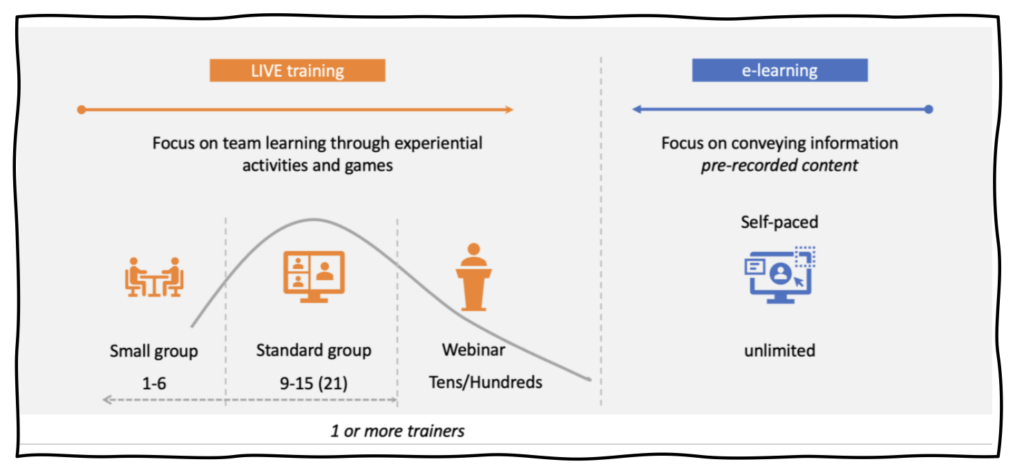What is the CARTA method?
CARTA is a method to design and deliver remote training sessions in ways that maximize the participants’ active involvement.
By “remote training” we mean a course format that is supported using video, audio, and specific remote technologies for synchronous interaction with the course participants.
This format is complementary to the traditional e-learning and online learning formats that offer participants access to sets of documents, pre-recorded videos, or other types of individual activities, they can consume at their own pace (that is, a-synchronously), in the absence of a trainer or educator.

Figure 1 – Live training vs e-learning
Certain elements of this method have been employed in past years, but the consolidation into a single form—the current one—was achieved thanks to the experimentation and the positive feedback received in 2020 by Axioma Solutions’ remote training team.
The team was able to successfully deliver more than 120, 2-day online sessions during a very tough period for the whole training industry worldwide.
Successful practices of the past have been preserved, refined, and validated in cooperation with other trainers from various activity domains who delivered remote sessions within local and global companies.
Why need a dedicated method for remote training?
Let’s take a look at the problems and opportunities.
As a participant
- Some participants may miss the enjoyment of traditional training
- Feeling not engaged and sceptical about the effectiveness of remote delivery
- Many of them report that online they received low value or even a mediocre experience
- It could be boring to offer your attention to a “talking head”, somebody that relies entirely on lecture
As a trainer
- You may accept that online delivery could lack the quality you usually offered when delivering in-class sessions.
- You may feel at a disadvantage as you don’t possess yet the knowledge and the tools to replicate the in-class experience online.
- You would like to enjoy the opportunities offered by the new approach and grow your reach.
The general public perspective
Managers, sponsors of learning initiatives, and clients, in general, acknowledge that the pandemic has accelerated the adoption of remote training (5+ years) by many organizations.
Nowadays, organizations across the world can see that this form of delivery with a trainer interacting synchronously with a group over Zoom has its clear advantages:
- Better budget spending with zero accommodation and travel costs frees financial resources to develop even more employees
- Greater flexibility in organizing training groups using a schedule of 4 to 8 hours.
As a consequence, they expect trainers to be able to deliver the same learning program both in-class and online, following a reasonably similar schedule of training activities and aiming at similar results.
CARTA Acronym
Collaborative, Adaptive, Remote, Training Activities
CARTA Method components
The method has the following components:
- The CARTA manifesto, the method’s pillars, values, and principles
- The process of delivery for remote training (i.e., strategies for participant involvement, roles, process steps, types of activities, content transformation, and adaptation)
- Remote learning best practices
- Library of activities, developed by the training community, organized and published by us.
What is the CARTA Method – Get a better understanding of it with the Visual Map
Explore the components in a visual comprehensive map of the CARTA method
Figure 2 – CARTA Method Visual Map